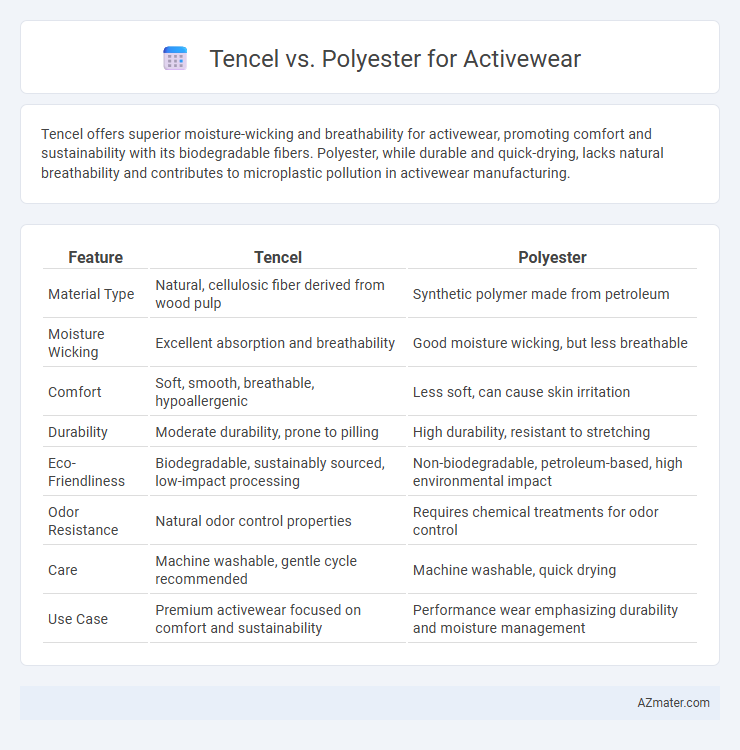Tencel offers superior moisture-wicking and breathability for activewear, promoting comfort and sustainability with its biodegradable fibers. Polyester, while durable and quick-drying, lacks natural breathability and contributes to microplastic pollution in activewear manufacturing.
Table of Comparison
| Feature | Tencel | Polyester |
|---|---|---|
| Material Type | Natural, cellulosic fiber derived from wood pulp | Synthetic polymer made from petroleum |
| Moisture Wicking | Excellent absorption and breathability | Good moisture wicking, but less breathable |
| Comfort | Soft, smooth, breathable, hypoallergenic | Less soft, can cause skin irritation |
| Durability | Moderate durability, prone to pilling | High durability, resistant to stretching |
| Eco-Friendliness | Biodegradable, sustainably sourced, low-impact processing | Non-biodegradable, petroleum-based, high environmental impact |
| Odor Resistance | Natural odor control properties | Requires chemical treatments for odor control |
| Care | Machine washable, gentle cycle recommended | Machine washable, quick drying |
| Use Case | Premium activewear focused on comfort and sustainability | Performance wear emphasizing durability and moisture management |
Introduction to Tencel and Polyester
Tencel, a sustainable fiber made from wood pulp, offers breathability, moisture-wicking properties, and biodegradability, making it ideal for eco-friendly activewear. Polyester, a synthetic fiber derived from petroleum, is known for its durability, quick-drying capabilities, and resistance to stretching and shrinking, commonly used in performance-focused athletic clothing. Comparing Tencel and polyester highlights differences in sustainability, comfort, and moisture management critical for activewear performance.
What is Tencel?
Tencel is a branded form of lyocell, a sustainable fabric made from sustainably sourced eucalyptus wood pulp through an eco-friendly, closed-loop production process that recycles water and solvents. Known for its exceptional moisture-wicking, breathability, and softness, Tencel enhances comfort and regulates body temperature in activewear. Unlike polyester, which is petroleum-based and less biodegradable, Tencel offers a biodegradable and renewable alternative ideal for performance apparel with an emphasis on sustainability.
What is Polyester?
Polyester is a synthetic fiber derived from petroleum-based polymers, widely used in activewear for its durability, moisture-wicking properties, and quick-drying capabilities. It offers excellent resistance to shrinking, stretching, and abrasions, making it ideal for high-performance and repetitive use in sports and fitness apparel. Despite being less breathable than natural fibers, advanced polyester blends often incorporate moisture management technologies to enhance comfort during intense physical activities.
Moisture-Wicking Capabilities
Tencel fibers exhibit superior moisture-wicking capabilities by efficiently absorbing and releasing sweat, keeping the skin dry and comfortable during intense workouts. Polyester, though less absorbent, excels at quick-drying and durability, making it a popular choice for activewear that demands fast moisture evaporation. Combining Tencel's breathability with polyester's resilience often results in hybrid fabrics optimized for moisture management and enhanced athletic performance.
Breathability and Comfort
Tencel fibers offer superior breathability compared to polyester, effectively wicking moisture away from the skin to keep activewear dry and comfortable during intense workouts. Polyester, while durable and quick-drying, tends to trap heat and moisture, potentially causing discomfort and decreased airflow. Choosing Tencel for activewear enhances comfort by promoting ventilation and reducing irritation, making it ideal for sensitive skin and extended wear.
Durability and Longevity
Tencel fibers, derived from sustainably sourced wood pulp, offer excellent breathability and moisture-wicking properties but generally lack the high durability and abrasion resistance found in polyester. Polyester, a synthetic fiber, excels in durability and longevity, making it a preferred choice for activewear that withstands frequent washing and intense physical activity without significant wear or deformation. For long-lasting activewear, polyester maintains shape and color better over time, whereas Tencel provides superior comfort but may degrade faster under heavy use.
Environmental Impact and Sustainability
Tencel, derived from sustainably sourced wood pulp, offers a biodegradable and renewable alternative to polyester, which is petroleum-based and contributes to microplastic pollution. The production process of Tencel utilizes less water and energy compared to conventional polyester manufacturing, significantly reducing its carbon footprint. Polyester's non-biodegradable nature and high reliance on fossil fuels make it a less sustainable option for eco-conscious activewear brands.
Odor Resistance and Skin Sensitivity
Tencel fibers offer superior odor resistance due to their natural moisture-wicking and antimicrobial properties, making them ideal for activewear that stays fresh longer during intense workouts. Polyester, while durable and moisture-wicking, tends to retain odors over time due to its synthetic nature and less breathable structure. For individuals with sensitive skin, Tencel's smooth, hypoallergenic fibers reduce irritation and dryness, whereas polyester can sometimes cause discomfort or allergic reactions from prolonged contact.
Cost and Availability
Tencel activewear typically costs more than polyester due to its sustainable production process and natural fiber content, appealing to eco-conscious consumers despite the higher price point. Polyester is widely available and much more affordable, benefiting from mass production and extensive distribution in global markets. The cost advantage and broad availability of polyester make it the preferred choice for budget-friendly activewear options.
Which Fabric Is Best for Activewear?
Tencel, a biodegradable fabric made from sustainably sourced wood pulp, offers superior moisture-wicking and breathability compared to polyester, making it ideal for activewear that requires comfort and eco-friendliness. Polyester, derived from synthetic polymers, excels in durability, quick-drying properties, and resistance to shrinking, making it a popular choice for intense physical activity and frequent washing. For activewear prioritizing sustainability and natural comfort, Tencel is best, while polyester suits high-performance needs requiring resilience and moisture management.

Infographic: Tencel vs Polyester for Activewear
 azmater.com
azmater.com